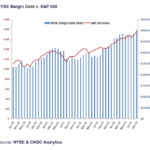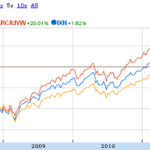Interest rates can’t stay low forever? Or can they?
This week famed value investor Jim Grant announced to a group of ETF insiders that he was short the bond market, making an explicit call that he believed that rates would rise faster than yields could reward investors.
The ETF space offers several opportunities for going long higher rates. Here’s what you need to know:
- Convexity pays better with longer dates – Longer dated bond investments carry higher rate risk, or, if you’re short, much better opportunity for higher returns.
- High rates help too – Fixed income products with higher interest rates are essentially levered to rising rates, since rising rates force companies to refinance at higher rates, which strains a company’s interest rate coverage.
- Staying away from safehavens is smart – US Treasury bond yields lead the rest of the bond market, but short-term movement into safehavens can temporary shock the bond market. Higher rates for corporate issues doesn’t necessarily mean higher rates in the short term for high-quality sovereign debt.
- Start closer to the top for credit quality – A rise in interest rates triggers higher financing costs for companies, less interest coverage with earnings, and a possible downgrade. For even the best companies, a fall from investment grade to speculative or junk ratings can be the end of a company.
- Avoid the Fed – It is on the long end where the Fed is most active, and where it will be most active for a long time.
Grant’s central thesis is that interest rates are simply too low and a 30 year bull run in bonds has to come to an end. He also pointed out one major problem discussed on this blog last week: ETFs distort junk debt markets. He blames junk debt ETFs like iShares iBoxx $ Investment Grade Corporate Bond Fund (HYG) and SPDR Barclays High Yield Bond ETF (JNK) for driving down yields for junk debt included in the indexes.
Grant says there’s mispricing as bonds that are not included in popular junk debt funds trade at a relative discount and higher yields to similar quality bonds in the indexes. One could reasonably assume such mispricing might also extend to higher quality issues, as wel.
Going Short in Bonds
Grant’s trade in the iBoxx $ Investment Grade Corporate Bond Fund (LQD) may be the best way to go long on rising interest rates by shorting the fund given that it fits within the above criteria.
The fund keeps a similar average maturity as bonds mature, so the primary factor at play is how much rates change, and the gain relative to the costs of going short.
Here are a few potential scenarios:
- Rates rise 1%: LQD falls by 6.5%
- Rates rise 2%: LQD falls by 12.4%
- Rates rise 3%: LQD falls by 18%
Going short will cost investors, though in the form of paying dividends and to borrow shares.
Effective Short Bonds Position
Shorting an ETF may not be workable for everyone, but even retail investors have a way to effectively short bonds: move to shorter maturities before reinvesting in longer dated bonds later at a higher interest rate. Similarly, we’ve covered the short Treasurys play in the event we see those holdings finally unwind, which many have called the trade of the century (just depends whether you can time it right!).
The move is simple, making it perfect for investors who stick with traditional asset allocation methodologies. Moving from a bond fund with a similar maturity profile as the iBoxx $ Investment Grade Corporate Bond Fund (LQD) to a money market fund from a bond fund is an effective short position on bonds. The loss is the difference in yield, the gain, however, is the potential for higher yields later. So long as rates rise by more than 1% in less than two years, 2% in less than three years, and 3% in less than four years, the move is profitable.
Following Jim Grant’s move is simple enough – and it will pay off big if rates move in a “quick and violent” fashion that he expects, and it doesn’t have to be as hard as going short.
Disclosure: No position in any tickers mentioned here.











{ 0 comments… add one now }